|
|
EDITORIAL: Eletrochromism Research in China
WANG Jinmin
2021 Vol. 36 (5): 449–450
 Abstract
Abstract(
786 )
 HTML
HTML(
48)
 PDF
PDF(186KB)(
1042
)
Electrochromism has been developed for more than 50 years since it was discovered in the 1960s. The optical properties, such as color, transmittance, reflectance and emissivity, of electrochromic materials can be changed reversibly under low applied voltages. Electrochromic materials have a wide range of regulatable spectrum, which can realize the broadband control from visible to mid far infrared. Electrochromic materials show a wide application prospect in the fields of intelligent window, display, anti-glare rearview mirror, intelligent thermal control and camouflage. In the past decade, electrochromism research has shown a trend of vigorous development, especially in China. Electrochromism is attracting researchers in the fields of nanomaterials, vacuum coating, lithium-ion batteries, supercapacitors, sensing and display to get involved in this interdisciplinary field, gradually becoming one of hot research topics. In the last special issue: Electrochromic Materials and Devices (2021, 36(2)), we published 5 papers. “Multi-functional Electrochromic Devices: Integration Strategies Based on Multiple and Single Devices”, “Electrochromic Devices Based on Tungsten Oxide and Nickel Oxide: a Review”, “Progress in Flexible Electrochromic Devices”, “Dynamic Process of Ions Transport and Cyclic Stability of WO3 Electrochromic Film”, and “High-conductivity Hydrophobic Fumed-SiO2 Composite Gel Electrolyte for High Performance Electrochromic Devices”. In this special issue, experts working in the field of electrochromism from Harbin Institute of Technology, Shanghai Institute of Ceramics, Chinese Academy of Sciences, Institute of Nanotechnology and Nano-Bionics, Chinese Academy of Sciences, Beihang University and University of Shanghai for Science and Technology contributed 5 papers. LI Yao’s group introduces the methods and principles of regulating the reflectance spectrum in the visible near infrared to mid far infrared bands and the latest research progress, and prospects the practical application of inorganic electrochromic materials in future. WANG Jinmin’s group introduces electrochromic materials and devices, preparation of molybdenum oxide films, modification of molybdenum oxide, and the research progress of molybdenum oxide based electrochromic devices. The paper also presents current existing problems and solutions of molybdenum oxide based electrochromic films and devices, and looks forward to their development prospects. DIAO Xungang’s group reports the preparation and electrochromic properties of lithium titanate thin films by spin coating method, and assembly of an all-solid-state inorganic electrochromic device. JIN Pingshi and CAO Xun’s group reports all-solid-state electrochromic devices based on LiAlOx/Ta2O5/LiAlOx (ATA) sandwich structured electrolyte fabricated by reactive DC magnetron sputtering technique. ZHAO Zhigang’s group reports the preparation of a multi-color tungsten oxide films with F-P cavity structure and their wide-spectrum electrochromic properties of visible and infrared spectral regions. The special issue of Electrochromic Materials and Devices focuses on the latest research progress and future development trends in the field of electrochromic, and hopes that colleagues will benefit from it. It is expected that the electrochromism research in China will develop more rapidly in the future, gradually leading the new trend of international electrochromism research.

|
|
|
Reflective Property of Inorganic Electrochromic Materials
ZHANG Xiang, LI Wenjie, WANG Lebin, CHEN Xi, ZHAO Jiupeng, LI Yao
2021 Vol. 36 (5): 451–460
 Abstract
Abstract(
1602 )
 HTML
HTML(
103)
 PDF
PDF(6871KB)(
2181
)
Optical property, such as color, transmittance, reflectance and emissivity, of electrochromic materials can be changed reversibly under low applied voltages. Electrochromic materials have a wide range of regulatable spectrum, which can realize the broadband control from the visible to mid-far-infrared. Electrochromic materials show a wide application prospect in the fields of intelligent window, display, anti-glare rearview mirror, intelligent thermal control, and camouflage. At present, most of researches on inorganic electrochromic materials focus mainly on transmission characteristics, but less on reflection characteristics. This is mainly because most inorganic electrochromic materials have single color and are not as easy to design as organic electrochromic materials. In recent years, through special preparation and structural design, the research on reflective properties of inorganic electrochromic materials has gradually attracted researchers’ attention. Based on reflection characteristics of inorganic electrochromic materials, methods and principles of regulating the reflectance spectrum in the visible near infrared to mid-far-infrared bands are introduced, and the latest research progress is summarized. Within the visible band, reflectance spectrum control is mainly achieved by vanadium pentoxide (V2O5) and V2O5 doping, microstructure of one dimensional photonic crystal, Fabry Perot nanocavity structure and localized surface plasmon resonance (LSPR). Within the mid-to-far infrared band, electrochromic devices (ECDs) based on the molecular vibration absorption of tungsten oxide (WO3) or other electrochromic materials and related theory are designed and fabricated to regulate reflectance spectra. Finally, the practical application of inorganic electrochromic materials in future is prospected.
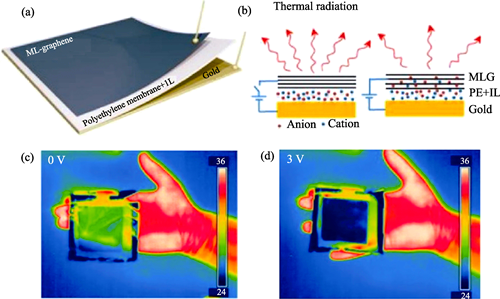
|
|
|
Molybdenum Oxide Electrochromic Materials and Devices
WANG Jinmin, HOU Lijun, MA Dongyun
2021 Vol. 36 (5): 461–470
 Abstract
Abstract(
1373 )
 HTML
HTML(
56)
 PDF
PDF(5538KB)(
1988
)
Electrochromic materials show reversible color-changeable characteristics, which are widely used in smart windows, displays, adjustable reflective mirrors, electronic paper, military camouflage and other fields. Compared with other kinds of display devices, electrochromic display devices have advantages of multi-colors, high contrast, no blind visual angles, and maintainable color after power off. As a typical cathodic colored electrochromic material, molybdenum oxide exhibits advantages of short response time and colored state closer to the sensitive wavelength band of the human eye to light, so that the electrochromic devices composed of molybdenum oxide is important in the research. This paper briefly introduces the definitions and applications of electrochromism, electrochromic materials and devices. In particular, electrochromic technology recently realized a demonstration application in smart phones, indicating the good prospects for the future development of electrochromic technology. We summarized mainly the research progress of the preparation of molybdenum oxide films, the modification of molybdenum oxide, and the molybdenum oxide based electrochromic devices. Finally, we presented current existing problems and solutions on molybdenum oxide based electrochromic films and devices with development prospects.
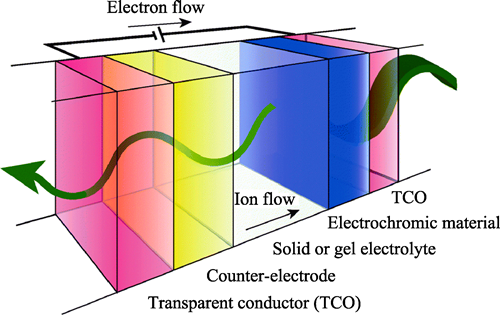
|
|
|
Preparation of Lithium Titanate Thin Film for Electrochromic Smart Window by Sol-Gel Spin Coating Method
WANG Tianyue, WANG Mengying, HUANG Qingjiao, YANG Jiaming, WANG Shunhua, DIAO Xungang
2021 Vol. 36 (5): 471–478
 Abstract
Abstract(
663 )
 HTML
HTML(
24)
 PDF
PDF(3830KB)(
1165
)
Electrochromic materials are attractive for applications like smart windows and thermal management which can modulate transmittance from visible to near-infrared wavelengths. Lithium titanate has been proven to be a potential electrochromic cathode material, but its application prospects in the field of smart windows still lack data support. In this work, Li4Ti5O12 thin films with high transmittance and good crystallinity were prepared by Sol-Gel spin coating. The electrochromic properties of the films were characterized by different methods. It is found that all Li4Ti5O12 thin films are very sensitive to the test conditions, such as scanning rate, displaying excellent dual band modulation property. Also, the thickness has a significant effect on the initial state transmittance, modulation amplitude, response time, voltage window and cycle durability of the Li4Ti5O12 thin films. The colored and bleached response time of the 450 nm Li4Ti5O12 is 19.1 and 8.9 s, respectively, while the transmittance modulation is 45% in the visible light region (550 nm). The performance of the films have not been significantly degraded after 20000 s continuous cycle. It is worth mentioning that the transmittance modulation in the near infrared band (1000 nm) is as high as 80%, showing excellent energy saving potential. Finally, Glass/FTO/Li4Ti5O12/LiNbO3/NiOx/ITO, an all-solid-state inorganic electrochromic device with good cycle performance from gray to blue was successfully assembled. Above data demonstrate that lithium titanate is a strong competitive material for the popularization of electrochromic smart window.
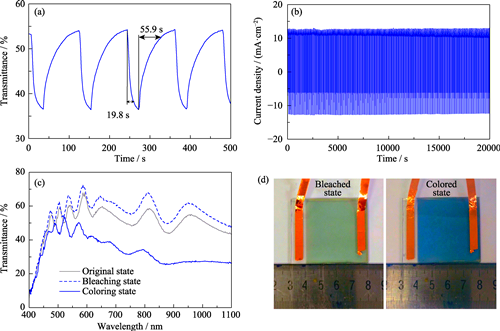
|
|
|
Sandwich Structured Electrolyte of High Sputtering Efficiency for All-solid-state Electrochromic Devices by Optical Design
JIA Hanxiang, SHAO Zewei, HUANG Aibin, JIN Pingshi, CAO Xun
2021 Vol. 36 (5): 479–484
 Abstract
Abstract(
619 )
 HTML
HTML(
26)
 PDF
PDF(1232KB)(
1174
)
The all-solid-state electrochromic devices (ECDs) have been widely developed for energy-saving windows, screen displays, multi-functional energy storage devices due to their characteristics such as large optical contrast, fast switching speed and good cycle stability. However, traditional all-solid-state ECDs based on monolayer electrolyte system are often limited by ordinary optical transmittance and inadequate sputtering efficiency. Herein, the all-solid- state ECDs integrated with LiAlOx/Ta2O5/LiAlOx (ATA) sandwich structured electrolyte were successfully fabricated by reactive DC magnetron sputtering technique. By means of introduction of ATA sandwich structured electrolyte, the prepared ECDs with seven layer (ITO/NiO/LiAlOx/Ta2O5/LiAlOx/WO3/ITO) was endowed with superfine optical transmittance and substantial sputtering efficiency simultaneously. The ATA-based ECDs realized satisfactory coloration efficiency of 79.6 cm2/C, fast switching speed as short as 1.9 s for coloring and 1.6 s for bleaching, and excellent cycling stability over hundreds of cycles. Furthermore, ATA sandwich structured electrolyte makes full use of the excellent ionic conductivity and stability of Ta2O5, as well as enough lithium ions to meet the demand for fast color switching. Hence, ATA-based all-solid-state ECDs by continuous DC sputtering is expected to provide effective guidance for the mass production and practical application of the high-performance ECDs.
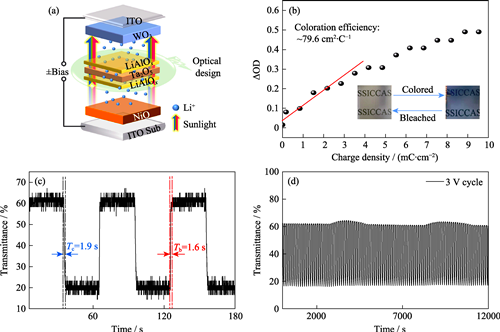
|
|
|
Infrared Electrochromic Property of the Colorful Tungsten Oxide Films
WU Qi, CONG Shan, ZHAO Zhigang
2021 Vol. 36 (5): 485–491
 Abstract
Abstract(
1116 )
 HTML
HTML(
36)
 PDF
PDF(4167KB)(
1473
)
Electrochromic materials are capable in a dynamically modulation over their absorption, transmission, reflection and emissivity covering the visible and infrared regions, which is recognized as one of the most effective strategies for an artificial control over the optical spectrum. In practical devices, the modulations for color (visible light) and heat (near-infrared irradiation) are both in demand, and thus it is of significant importance to achieve the dual-band control within single electrochromic device. However, the present design of electrochromic materials mainly focuses on the adjustment ability of visible spectrum or color transformation, while leaving the modulation of infrared spectra often negligible. In this study, a multi-color tungsten oxide film with F-P cavity structure is selected to explore the wide-spectrum electrochromism of visible and infrared spectral regions. The tungsten oxide film material with F-P cavity structure presents diversified and bright colors in the visible region with various color patterns, and diversified color alternation can be realized under applied biases. At the same time, the infrared reflectance of colorful tungsten oxide films can also be modulated significantly, for example, infrared modulation rates higher than 25.00% can be obtained in the middle wavelength (around 3.5 μm) in the colored films. The research shows that the multi-color tungsten oxide film can realize the discrete and controllable adjustment of the visible and infrared spectral region in the wide spectrum, and has great potential in the application of smart window, thermal management, radiative cooling and other fields, which can even achieve the in-demand cooperative modulation of light and heat performance.
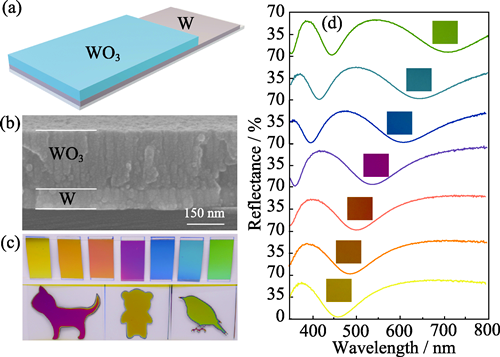
|
|
|
Piezoelectricity of Graphene-like Monolayer ZnO and GaN
XIANG Hui, QUAN Hui, HU Yiyuan, ZHAO Weiqian, XU Bo, YIN Jiang
2021 Vol. 36 (5): 492–496
 Abstract
Abstract(
650 )
 HTML
HTML(
28)
 PDF
PDF(846KB)(
1304
)
 Mobile PDF
Mobile PDF(846KB)
By employing density functional theory calculations, the mechanical, electronic and piezoelectric properties of graphene-like monolayers ZnO (g-ZnO) and GaN (g-GaN) were investigated. Elastic stiffness constants and piezoelectric tensors of monolayers g-ZnO and g-GaN using their Clamped-ion and Relaxed-ion components were mainly studied. Results indicate that these two graphene-like structures are semiconductors with excellent elasticity. The piezoelectric coefficient of monolayers g-ZnO and g-GaN are about 9.4 and 2.2 pm·V-1, respectively, implying their piezoelectric effect in extremely thin film devices, especially the g-ZnO. The remarkable piezoelectricity of monolayer g-ZnO enables it a wide range of applications, such as mechanical stress sensors, actuators, transducer and energy harvesting devices.
|
|
|
Preparation and Property of GDC-LSF Dual-phase Composite Membrane with Straight Pores and Sandwich Structure
ZHENG Qifan, LI Chaoqun, BAN Xiaokuan, ZHAN Zhongliang, CHEN Chusheng
2021 Vol. 36 (5): 497–501
 Abstract
Abstract(
449 )
 HTML
HTML(
10)
 PDF
PDF(976KB)(
771
)
The dense ceramic oxygen-permeable membrane has attracted much attention due to its potential applications in production of oxygen from air and manipulation of oxygen-consuming industrial chemical processes. In the present study, Gd0.1Ce0.9O2-δ-La0.6Sr0.4FeO3-δ (GDC-LSF) dual-phase composite membrane was prepared using the phase-inversion tape casting/lamination/sintering method. The as-prepared membrane consisted of an 80 μm thick dense oxygen separation layer sandwiched between two 420 μm thick finger-like porous support layers. The inner surface of the support layers was further modified with Nd2NiO4+δ (NNO) nanoparticles using the impregnation method. An oxygen permeation flux of 1.53 mL·cm-2·min-1 was measured at 900 ℃ by exposing one side of the membrane to a flowing air stream and the other side to a flowing He stream. When CO2 was used as sweep gas, an oxygen permeation flux of 0.6 mL·cm-2·min-1 was obtained, and no decrease in the flux was observed during 90 h of testing. The membrane remained intact after experiencing over 70 thermal cycles between 800 and 900 ℃. GDC-LSF dual-phase composite membrane with straight pores and sandwich structure has demonstrated satisfactory combination of oxygen permeability, chemical stability and thermal mechanical strength, promising for applications in separation of oxygen from air and oxy-fuel combustion with CO2 capture.

|
|
|
Pressure-resistance of Magic-sized Cadmium Selenide Nanocrystals
JIANG Hongmei, ZHAO Wenya, FU Ruijing, XIAO Guanjun
2021 Vol. 36 (5): 502–506
 Abstract
Abstract(
414 )
 HTML
HTML(
13)
 PDF
PDF(2539KB)(
757
)
Exploration of pressure-resistant materials largely facilitates the operation under extreme conditions where the stable structure and properties are highly desirable. Magic-sized nanocrystals (MSNs) are of great interest due to their well-defined structure, ultra-small particle size, and precise atomic composition. Here, we reported the colloidal synthesis of CdSe MSNs with a sharp first exciton absorption peak at 463 nm. The corresponding photoluminescence (PL) spectrum exhibited a very narrow full width at half-maximum (FWHM) of about 13 nm. In situ high-pressure evolutions of PL and absorption unambiguously indicated that the peak position of as-prepared CdSe MSNs kept nearly unchanged with the pressure increasing. This behavior was completely different from conventional materials upon the stimulus of external pressure. Furthermore, the decompressed samples retained the original structure and morphology of CdSe MSNs. The properties of good pressure resistance of the CdSe MSNs are reflected in the process of pressurization, which improves the research of the magic-sized materials under extreme pressure.

|
|
|
CsPbBr3@TiO2 Core-shell Structure Nanocomposite as Water Stable and Efficient Visible-light-driven Photocatalyst
XIAO Xiang, GUO Shaoke, DING Cheng, ZHANG Zhijie, HUANG Hairui, XU Jiayue
2021 Vol. 36 (5): 507–512
 Abstract
Abstract(
971 )
 HTML
HTML(
42)
 PDF
PDF(2515KB)(
1478
)
The inherent poor stability of CsPbBr3 perovskite quantum dots (QDs) is the main impediment restricting their applications. In this work, a CsPbBr3@TiO2 core-shell structure nanocomposite with high water stability and efficient photocatalytic activity was fabricated through the hydrolysis of tetrabutyl titanate, followed by calcination. The as-prepared CsPbBr3 QDs have a size of ca. 8 nm, encapsulated by incompletely crystallized TiO2 protective layer with a thickness of ca. 20 nm. The photocatalytic performance of the CsPbBr3@TiO2 nanocomposite was investigated by degradation of Rhodamine B (RhB) in water under visible light irradiation. The result shows that the CsPbBr3@TiO2 nanocomposite exhibits much more enhanced photocatalytic activity than pure TiO2 and CsPbBr3 perovskite quantum dots. The photocurrent test results showed that the formation of the CsPbBr3@TiO2 heterostructure can promote the separation of photogenerated carriers, which led to the improvement of photocatalytic performance of the composite material. More importantly, TiO2 can act as a protective layer to separate CsPbBr3 from water, which brings about the high water stability of the CsPbBr3@TiO2 nanocomposite. After photocatalytic degradation of pollutants, the recovered CsPbBr3@TiO2 nanocomposite retained its original morphology, luminescent and photocatalytic properties.
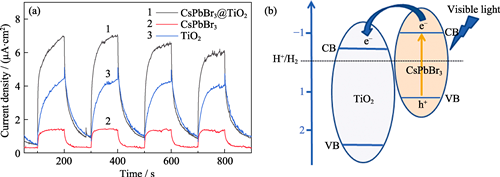
|
|
|
Valence State Control of Manganese in MgAl2O4:Mn4+ Phosphor by Varying the Al2O3 Crystal Form
WANG Zhaowu, JI Haipeng, WANG Feixiang, HOU Xinghui, YI Shasha, ZHOU Ying, CHEN Deliang
2021 Vol. 36 (5): 513–520
 Abstract
Abstract(
968 )
 HTML
HTML(
23)
 PDF
PDF(1302KB)(
1182
)
Mn4+ activated red phosphor is one of the current research hot-spots in the field of white light emitting diodes (wLEDs). The shortest emission of Mn4+ 2E→4A2 transition in aluminate is 651 nm realized in MgAl2O4, but the doped manganese ions exists in multiple valence states (+2/+4/+3, etc.) due to the fact that there exist two cationic sites (Mg2+/Al3+) forming tetrahedron or octahedron coordination in the spinel structure. In this study, variation of the Al2O3 polymorphs (γ/α ratio) in the starting materials and post-annealing were used to control the doping sites and valence state of manganese ions in the MgAl2O4 structure. The results show that a high α/(α+γ) ratio of starting Al2O3 favors the formation of Mn2+ while a low α/(α+γ) ratio of starting Al2O3 favors the formation of Mn4+ dopant. By using highly active nano-γ-Al2O3 as the Al3+-bearing source, the occupancy of manganese ions in the Mg2+ site and the formation of Mn2+ valence state were effectively suppressed. Bright and pure MgAl2O4:Mn4+ phosphors in which only the red luminescence from Mn4+ was observed in the visible spectral region were successfully prepared via once heat treatment at 1550 ℃ for 5 h in air. The intrinsic reason for the dependence of manganese doping valence state on the Al2O3 polymorph lies in that the reactivity of Al2O3 determined the sequences of doping reactions and then the doping site/valence of manganese ions in MgAl2O4:Mn. All the above data demonstrated that the control of reaction sequences was a new method to regulate the valence state of manganese in aluminate phosphors.
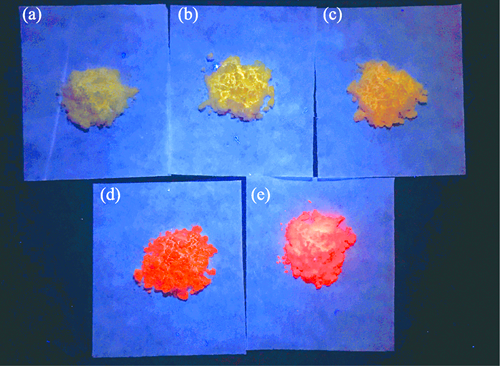
|
|
|
Effects of γ-Irradiation and Thermal Annealing on Photo-thermal-refractive Glass
ZHU Zhiyu, JIAO Yan, SHAO Chongyun, HE Dongbing, HU Lili
2021 Vol. 36 (5): 521–526
 Abstract
Abstract(
394 )
 HTML
HTML(
7)
 PDF
PDF(6863KB)(
788
)
Photo-thermal-refractive (PTR) glass was irradiated with γ-ray at the total dose of 0.35, 1, 10 and 100 kGy, respectively, and then annealed. Irradiation mechanism of the photo-thermal-refractive glass was studied by absorption spectroscope, luminescence spectroscope and electron paramagnetic resonance. The results showed that the absorption of the γ-irradiated PTR glass in the visible light was mainly caused by the Ag0, silver molecular clusters Ag2, Ag3, silver nanoparticles Agm0, and non-bridge oxygen hole center HC1 and HC2. Under different doses of γ-ray irradiation, valence state of the ions (Ag+, Ce3+) in the glass matrix changed. At the same time, non-bridged oxygen bonds in the glass matrix broke, generating non-bridged oxygen hole defects HC1, HC2 and Ag0. With the increase of the radiation dose, silver molecular clusters Ag2 and Ag3 generated, and the concentration of HC2 center in the glass matrix increased, resulting in enhanced absorption near 639 nm. After being irradiated and annealed at 250 ℃, HC1 and HC2 defect centers was bleached. Silver molecules appeared after annealing at 430 ℃, of which absorption peak had a redshift and was broadened with the increase of annealing duration.
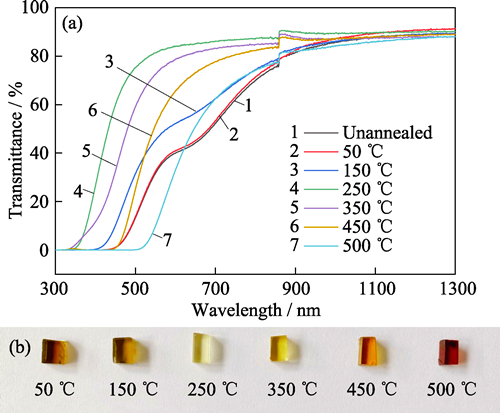
|
|
|
Performance of Nitrogen-doped Hollow Carbon Spheres as Oxidase Mimic
ZHENG Yanning, JI Junrong, LIANG Xueling, LAI Zhengjie, CHENG Qifan, LIAO Dankui
2021 Vol. 36 (5): 527–534
 Abstract
Abstract(
467 )
 HTML
HTML(
21)
 PDF
PDF(4979KB)(
969
)
Due to efficient performance and stability, nanozymes have recently attracted much attention in bioreaction. In this work, a facile approach for preparing N-doped hollow carbon sheres (N-HCSs) by using CaCO3 spheres as green template and polydoamine as nitrogen and carbon sources was reported. Morphologies and structures of the samples were characterized. Using TMB (3,3,5,5° tetramethylbenzidine) as a substrate, UV spectra photometry was used to investigate its oxidase-like activity and catalytic mechanism. The results showed that N-HCSs displayed oxidase-like activity. The oxidase-like activity of N-HCSs increased by three times after activation by KOH. These enzymes conform to the Michaelis-Menten kinetic equation, and the Km constant before and after activation were 0.105 and 0.083, respectively, indicating good affinity for substrates. The data demonstrate that it is superoxide anion (O2? -) that plays a major role in catalytic reaction. This work data provides a theoretical basis for the design and preparation of high activity oxidase-mimicking enzymes.
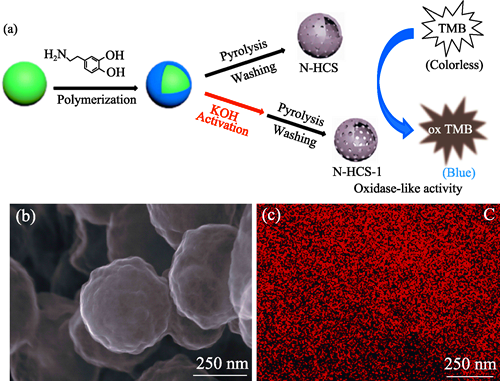
|
|
|
Mechanical and Dielectric Properties of Hot-pressed Si3N4 Ceramics with BaTiO3 Addition
LIANG Hanqin, YIN Jinwei, ZUO Kaihui, XIA Yongfeng, YAO Dongxu, ZENG Yuping
2021 Vol. 36 (5): 535–540
 Abstract
Abstract(
416 )
 HTML
HTML(
18)
 PDF
PDF(1761KB)(
757
)
Si3N4 ceramics with improved and tailorable dielectric constant are desirable for microwave dielectric substrate application in harsh environment. Effect of BaTiO3 addition on the mechanical and dielectric properties of the hot-pressed Si3N4 ceramics with Al2O3 and Nd2O3 as sintering additives were investigated. Relative density, flexural strength and Vickers’ hardness of Si3N4 ceramics all decreased, while indentation fracture toughness increased monotonically with the increase of BaTiO3 content. Flexural strength of Si3N4 ceramics was higher than 600 MPa and dielectric constant of Si3N4 ceramics increased to 9.26-11.50 when 5wt%-20wt% of BaTiO3 was added. The dielectric loss was at the level of 10-3. The improvement of dielectric constant was attributed to the formation of TiN during hot pressing, as crystalline BaTiO3 was not detected in the sintered samples. These findings can make a significant contribution to the new applications of Si3N4 ceramics.
|
|
|
Zr2Al3C4 Coatings on Zirconium-alloy Substrates with Enhanced Adhesion and Diffusion Barriers by Al/Mo-C Interlayers
YE Wenhao, WEI Qiang, LIANG Jiamin, ZHOU Jie, MENG Fanping, EKLUND Per, HUANG Qing
2021 Vol. 36 (5): 541–546
 Abstract
Abstract(
458 )
 HTML
HTML(
10)
 PDF
PDF(1868KB)(
842
)
Zircaloy coating is one of the crucial technical ways to improve the accident tolerance of nuclear fuel cladding, which enables the zirconium-water reaction problems to be solved. Zr2Al3C4 coating is one type of candidate solutions to improve the high-temperature oxidation resistance of zirconium claddings. However, little study has been performed on the synthesis of Zr2Al3C4 coatings on zirconium alloy substrates due to the inter-diffusion, as well as the difference of the thermal expansion coefficients between the Zr2Al3C4 coating and the substrates. In this study, Zr2Al3C4 coatings were prepared through room-temperature magnetron sputtering and post annealing on zirconium alloy (ZIRLO) substrates with magnetron-sputtered Al/Mo-C interlayers. The effects of Al/Mo-C interlayers on phases and microstructures of Zr-Al-C coatings after annealing were studied by different methods. It is found that the coatings without interlayer are broken and no Zr2Al3C4 phase is formed due to significant interdiffusion between the Zr-Al-C coating and the substrate during annealing at 800 ℃ for 3 h. The Al/Mo-C interlayers prevented elemental diffusion between Zr-Al-C coatings and substrates during the post-annealing process. The Al/Mo-C interlayers act as diffusion barriers and greatly reduce the stoichiometric deviations from Zr2Al3C4 phase, which facilitates the formation of the Zr2Al3C4 phase in the final coating. Moreover, this diffusion-barrier layers contribute to eliminating cracks induced by the difference of the thermal expansion coefficients between the Zr2Al3C4 coatings and substrates. At the same time, the adhesions between Zr-Al-C coatings with Al/Mo-C interlayers and substrates were improved after annealing, with their strength exceeding 30 N.
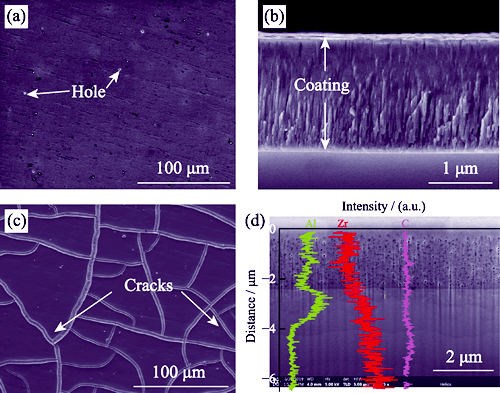
|
|
|
Strong SiC Porous Ceramic Obtained by Sintering of Reticulated Aligned SiC Nanowires
ZHU Quan, HU Jianbao, YANG Jinshan, ZHOU Haijun, DONG Shaoming
2021 Vol. 36 (5): 547–551
 Abstract
Abstract(
540 )
 HTML
HTML(
40)
 PDF
PDF(2330KB)(
904
)
High strength SiC porous ceramic with reticular pore structure is assembled by cross-lamination of layers comprised by aligned SiC nanowire (SiCNWs) struts printed through direct ink writing. SiCNWs networks exhibit a structure with highly interconnected porosity and an architecture formed by aligned SiCNWs struts. The effects of sintering temperature on the structures, phase evolutions and mechanical properties were studied. The high aspect ratio of SiCNWs was kept well at sintering temperature lower than 1900 ℃. The bulk density, porosity and median pore diameter of aligned SiCNWs porous ceramics sintered at 1850 ℃ were 1.49 g/cm3, 54.6% and ~1 μm, respectively. Due to the effect of orientation and high strength of SiC nanowire struts, compressive strength of (245.5±0.7) MPa is achieved.
|
|
|
Construction of Hydroxyapatite Nanoceramics with High Mechanical Strength and Efficiency in Promoting the Spreading and Viability of Osteoblasts
WU Yonghao, LI Xiangfeng, ZHU Xiangdong, ZHANG Xingdong
2021 Vol. 36 (5): 552–560
 Abstract
Abstract(
472 )
 HTML
HTML(
26)
 PDF
PDF(5906KB)(
950
)
The present study focuses on the construction of HA nanoceramics with excellent mechanical property and osteogenic activity, and the correlation between HA precursor powders and resulting ceramics. Three precursor powders were used, i.e. HA-40 synthesized at 40 ℃, HA-40PEG synthesized at 40 ℃ with PEG as a template, and HA-80 synthesized at 80 ℃. The results showed that grain sizes of three HA ceramics prepared by HA-40, HA-40PEG, and HA-80 precursors were (217.87±57.53), (123.22±20.16), and (316.65±68.91) nm, respectively. It demonstrated that compared with HA-40 and HA-80, HA-40PEG was more beneficial for fabricating HA nanoceramics. Among three resulting ceramics, HA-40PEG displayed the highest comprehensive strength (~300 MPa). In addition, the nano-scale HA-40PEG ceramics promoted better cell spreading and proliferation than those of submicro-scale HA-40 and HA-80 ceramics. These findings suggest that the preparation of HA precursor powders plays an important role in fabricating HA nanoceramics with simultaneous improvement of mechanical and biological properties.
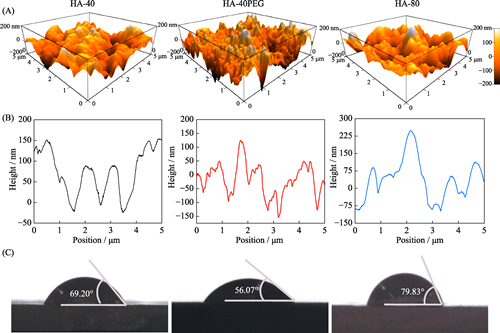
|
|